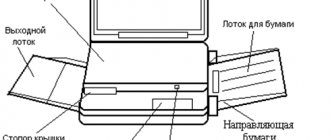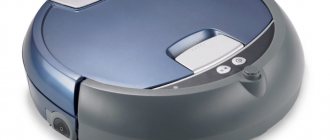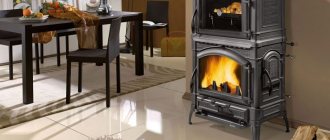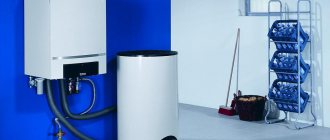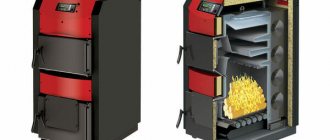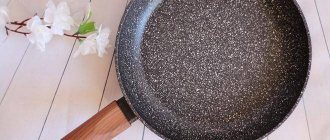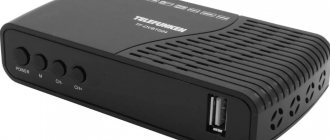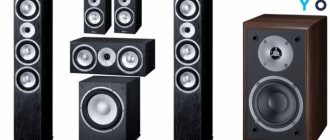When designing, purchasing, and installing heating systems and hot water supply systems, it is necessary to take into account a number of factors that influence the features and cost of operating heating devices and the efficiency of their use. Almost all people who have wondered about autonomous heating of their home/cottage are interested in the question: is it possible to have economical and, at the same time, comfortable heating using a solid fuel boiler?
Currently, many consumers prefer to use gas boilers, and solid fuel boilers are rarely used. But times change, and gas prices change with them. This is one of the most important reasons why you should know how to choose the right solid fuel boiler.
Choosing the optimal solid fuel boiler involves determining a number of parameters. Let's focus on the main ones.
Power of a long-burning solid fuel boiler
The first thing we pay attention to is the power of the boiler. Conventionally, ten square meters require 1 kW of power. But this is only conditional. The power calculation should be carried out by a heating engineer based on thermal calculations, tabular, reference, and regulatory documents, taking into account the structural and architectural features of the building, climatic conditions, heat losses - there are a very large number of factors. Therefore, it is better to entrust the choice of power to professionals. Our specialists will make all the necessary calculations free of charge and at a high professional level. All solid fuel boilers on the market are divided into two large groups based on power:
- for individual heating systems with a power of up to 100 kW;
- for general heating systems, industrial boilers with a power of over 100 kW.
One important point. It is advisable to take the boiler power with a reserve, preferably a little more, in order to use the equipment in low-intensity combustion mode, by adjusting the volume of primary air supply, this increases the efficiency of use of the equipment and simplifies operation. And yet, the power of the boiler directly depends on the calorie content of the fuel, this factor also needs to be taken into account.
Types of designs of long-burning solid fuel boilers
From the information presented above, it is already clear that the main task when operating boilers of this design is to achieve the correct dosage of air flows: primary air entering the fuel chamber, and secondary air, which is responsible for the high-quality complete combustion of pyrolysis gases.
Models from different manufacturers solve these problems in different ways. That is, the design of boilers can be equipped with additional devices that balance the processes taking place.
Prices for solid fuel boilers
solid fuel boilers
Forced air boilers
One of the design options is boilers with a built-in fan, which is used to pump air. The distribution of air flows among the chambers through internal channels is carried out using an automatic control unit.
Diagram of a long-burning boiler with a built-in fan for air injection
Almost all boilers equipped with fans are arranged in such a way that the main loading chamber is located in the central part of the structure.
Thanks to the presence of a fan, the fuel quickly flares up, and the heat-resistant materials with which its internal walls are usually lined (ceramic concrete or fireclay) perfectly accumulate heat. The draft created in the furnace constantly supplies the pyrolysis gas released by the fuel to the afterburner chamber, which in some models is located at the bottom. At the entrance to this space, special ceramic nozzles are installed that can withstand temperatures reaching up to 1000 degrees.
When burned, pyrolysis gases heat the water jacket pipes. In turn, the heating circulation pump, installed in the heating circuit and also connected to the automatic unit, ensures the required intensity of coolant movement throughout the entire heating system.
In some models of solid fuel boilers, the afterburner may be located in the rear or upper part of the boiler structure.
A variant of a long-burning boiler with an afterburner located in the rear part of the structure.
If the afterburning chamber is located at the rear of the boiler, it has a rather complex design of heat exchange elements, which facilitates rapid heating of the coolant. Thanks to this, high efficiency of the device is achieved, sometimes reaching 90–95%.
Such designs of electronically controlled boilers have a large number of advantages, but they also have their own significant drawback - they are energy dependent. In the event of a power outage, the fans, pump, and naturally, the entire automatic unit do not function, which leads to a suspension or complete stop of the movement of coolant through the heating circuit. If power outages are not uncommon for the area where the house is located, then it is necessary to have an autonomous power supply system - this could be an electric generator, which must always be kept in a state of full readiness. UPS, uninterruptible power supply units specially designed for this purpose, help prevent infrequent and not too long interruptions.
You may be interested in information on how to make a heat accumulator for a solid fuel boiler with your own hands
Another serious disadvantage of a boiler with an electronic control system is its high sensitivity to voltage changes. Therefore, it is necessary to provide them with protection by installing a separate voltage stabilizer.
Voltage stabilizer - guarantees correct operation of the boiler electronics
You shouldn’t waste money on this device - its cost is not comparable to the cost of a boiler full of electronics, and skimping on such precautions can result in much higher costs! How to choose a voltage stabilizer for a heating boiler - read in a special publication on our portal.
Non-volatile heating devices
To avoid dependence on the stability of the power supply, it is worth choosing long-burning units with natural air draft and equipped with a mechanical control system. There are many such models on the market. For example, these are the familiar domestic or Trayan boilers.
Solid fuel boiler "Burzhuy-K".
Prices for solid fuel boiler "Burzhuy-K"
Burzhuy-K
These devices have a volumetric fuel chamber located in the lower part of the structure, under which there is a blower, which simultaneously serves as an ash pit. The damper for air access, located at the bottom of the door, is connected by a chain to the thermostat.
When igniting firewood loaded into the firebox, it is necessary to open the damper as much as possible to ensure active combustion of the fuel and start the pyrolysis process. To achieve it, a temperature of at least 200 degrees is required.
After a fire, the damper should be closed, reducing to a minimum the access of oxygen to the fuel chamber, transferring the combustion to the smoldering stage. Further, as already described above, pyrolysis gases are released, which enter and ignite in the afterburner.
Thanks to this design, the heating device is completely energy independent, so even in the absence of electricity, the house will continue to be supplied with heat.
This type of boiler is inferior in efficiency and fuel economy to energy-dependent devices, however, it is its independence from the availability of electricity that makes it popular among consumers. In addition, you will also not have to pay for energy consumption, which will also help save on the operation of the heating system as a whole.
Solid fuel boilers with top combustion
Another design option for heating units is the original technological systems with the direction of wood burning from top to bottom. A similar principle is used not only in many models of solid fuel boilers, but also in stoves operating on the principle of long combustion.
Boilers with top ignition, as a rule, have the shape of a cylinder located vertically. Almost all types of solid fuel are suitable for this type of heating units - firewood, briquettes, coal, wood chips, sawdust, etc. The chamber in such boilers has a very large volume, which allows them to operate on one fuel load for a long time: this duration depends on the specific model and fuel type. For example, some of them are capable of working with wood from 24 hours to three days, and when using coal - even from three to seven days.
Solid fuel boiler of a cylindrical shape with top combustion of wood.
The operating cycle of such a boiler can be represented in the following order:
The principle of operation of a boiler with top combustion of fuel filling
So, such a boiler has a cylindrical vertical body (item 1).
Through a special door (item 2) the selected fuel (item 3) is loaded into the chamber. At the very bottom there is a door (item 4), which serves to clean the chamber from ash before the next loading.
If firewood is used for heating, then large-diameter logs are laid down and in the middle of the stack, and wood chips are loaded around them and on top. Then, using paper, the top thin wood is ignited. To ignite fuel, you can use liquids specially designed for igniting stoves.
In the upper part of the housing there is an air supply channel (item 5) to the boiler, equipped with a valve. The valve can be manual or semi-automatic, operating on the principle of changing the configuration of a bimetallic plate under the influence of temperature. Air from this channel enters the heating chamber (item 6), where it is heated under the influence of the heat generated by the boiler.
As soon as surface burning of the wood begins, a special air distributor (pos. 7) is lowered onto the stack. This is a rather massive part made of a metal profile, inside of which there are channels for uniform distribution of air over the surface of the burning fuel. With its weight, the distributor rests on the burning bookmark, and as it burns out, it gradually falls down. To do this, it is connected to the air heating chamber by a pipe of a special telescopic design (item 8).
The air heating chamber has a damper (pos. 9), which regulates the flow of secondary air into the upper part of the combustion chamber (pos. 10).
Pyrolysis gases released during the smoldering of the top layer of the fill rise to the upper part of the fuel chamber, where they meet the flow of hot secondary air coming from above. That is, all the necessary conditions are created for their complete afterburning with a large release of heat. After this, gaseous waste is discharged through the pipe (item 11) into the chimney.
The generated heat is transferred to the water jacket of the boiler (item 12), which is connected to the heating circuit of the system through the return (item 13) and supply pipes (item 14).
As you can see, in fact, in this design there is no obvious division into a chamber for preliminary combustion of wood and final combustion of gases - the total space is divided into these zones by the position of the air distributor, and the sizes of these zones change as the unit operates.
Such boiler models can also be equipped with a built-in fan, which provides forced air supply. However, even their work can be carried out in the presence of only natural traction. Therefore, the heating of the house will work even in the absence of electricity.
This design has shown its effectiveness, so some home craftsmen take it as a basis when creating their own products. A striking example of this is the popular wood-burning stove with the unusual name “Bubafonya”.
You may be interested in information about what a bypass is in a heating system
Types of fuel for a solid fuel boiler
The second parameter that you need to pay attention to is the type of fuel on which the boiler operates. Modern heating boilers can operate on different types of fuel and/or a combination of fuel types, the choice of which directly depends on the region, climatic and natural characteristics. In Siberia, the lowest cost type of fuel is firewood (wood waste) and coal, so solid fuel heating boilers are the most optimal solution. In addition to firewood and coal, this type of heating equipment can operate on solid waste from agriculture, forestry and pellets. Combination boilers are more difficult to operate and are more expensive, but are highly versatile. Choose solid fuel or types of fuel based on its availability on the market and price. In Siberia, the available species are:
- coal, stone Montenegrin, Balakhtinsky and Borodino brown, when purchasing coal you need to pay attention to its fraction and grade, they must coincide with the technical operating conditions of the boiler;
- firewood, birch, pine, from other types of wood, you can buy chopped immediately, the secret of choice is simple - the lower the moisture content of the firewood, the better, especially when it comes to pyrolysis, gas-generating boilers, wet firewood will kill such a boiler in three seasons maximum, so there is room for storage must be protected from moisture and precipitation, the moisture content of firewood for a gas generator boiler is no more than 20%, wet firewood can be used in classic, traditional boilers, but is not advisable.
The third
common option is pellets, on which pellet boilers operate.
These are granules that are produced from wood waste and waste from various areas of agriculture. Choosing the right pellets is a whole science; color, shape, and structure are important. Pellets are perhaps one of the best types of solid fuel, if there were one problem - price and availability on the market. Pellet boilers and pellets are more expensive than firewood and coal, but cheaper than gas and electricity. You need to understand that such solid fuel heating systems are for the future. More and more new manufacturers are appearing on the market, supply is growing, which means that problems with where to buy disappear and the cost of fuel is decreasing. Pellet boilers can be automatic or semi-automatic; they differ in the type of burner (torch, volumetric combustion, fireplace). Pros: ease of maintenance, very high performance (efficiency). Cons: high cost of heating equipment and fuel. Solid fuel boilers can also operate on waste from various areas of agriculture and the woodworking industry. SEG Bio
boilers . The main advantage of such boilers is the low cost of fuel. We also note fuel briquettes made from peat, oil shale, there are other options. Conventionally, there are two groups based on power:
- solid fuel heating boilers for private homes (with a power of up to 100 kW);
- long-burning industrial solid fuel boilers (power over 100 kW).
Types of long-burning boilers
Long-burning solid fuel boilers are divided into groups depending on the type of fuel used (wood, coal, pellets) and its supply (manual loading, automatic), design (combustion method) and the corresponding burning time.
Boilers with manual fuel loading.
These boilers, in turn, differ in the method of burning fuel.
| • Long burning boilers Stropuva (Lithuania) - a leader among long-burning boilers with manual loading. Stropuwa boilers are cyclic type, single-circuit, the burning time of one load of fuel reaches 30 hours on wood and 7 days on coal . The devices use a patented top combustion method, when the fuel burns not as usual - from below, but from above. The combustion zone shifts as the fuel burns from top to bottom. And air is supplied to the combustion zone using a telescopic system. The design is very simple, original and reliable. Boiler power is from 8 to 40 kW. Heated area - from 30 to 400 m2. Modifications: Read more about boilers... |
| • Pyrolysis boilers (gas generators) - long-term combustion is achieved through the pyrolysis method of burning wood gases released when wood burns at high temperatures. This combustion method produces no soot and a minimal amount of ash. Burning time of one stack of firewood 8-10 hours , which is 7 times less than that of Stropuva. |
Boilers with automatic fuel supply - pellet boilers.
In pellet boilers, long-term combustion without human intervention is achieved using granulated fuel (pellets). Pellets for boilers (biogranules) are poured into a hopper and supplied to the combustion zone automatically as needed, which, together with automatic ignition and temperature control, allows for maximum automation of the process. You may not go near the boiler for weeks. Pellets are made from finely crushed and pressed waste from the wood processing industry (sawdust, etc.), seed husks, nut shells, cake, seeds, etc. If necessary, you can heat not only with pellets, but in their absence, with wood and coal. Pellet boilers have become very widespread and are usually classified as a separate type.
| Boilers KOSTRZEWA (Poland) Power: from 10 to 200 kW. Heated area: from 50 to 2600 m2. |
| FACI boilers (Russia) Power: from 15 to 645 kW. |
| Grandeg boilers (Latvia) Power: from 25 to 500 kW. Heated area: from 150 to several thousand m2. |
Operating principle of a solid fuel boiler
The third
important point is the principle of operation of the boiler.
There are three main options. The first
is traditional boilers, similar to a regular stove, fuel burns from the bottom up. Pros: simplicity of design, ease of maintenance, low cost, low requirements for the quality of solid fuel used, energy independence (installing automation on such boilers is money down the drain).
- Disadvantages
- low efficiency (
70-75%
), difficulty in maintaining a given temperature regime of the coolant, the need for constant care, supervision and fuel supply (
burning time is about 3-4 hours
).
This is an excellent solution for houses with seasonal residence, small in area, in systems with natural, gravity coolant circulation and the possibility of monitoring equipment. Pay attention to the German solid fuel classic boilers “ Buderus
”
Logano
and domestic “
ZOTA
”
Carbon
.
The second
is long-burning boilers. Their operating principle is similar to burning a match or candle. That is, fuel burns from top to bottom.
- The advantages of this scheme
are a long combustion period (wood up to three days, coal up to five days), very high productivity (
efficiency of about 80%
), in a number of models complete energy independence, low requirements for solid fuel (a controller and a blower fan are needed), combustion automation in energy-dependent models, environmental friendliness when used correctly.
- Disadvantages
- higher cost compared to traditional boilers, most models are energy dependent (without electricity, the automation cannot work), adherence to fuel loading technology (requires very dense installation), difficulties with incomplete loading, inability to reload.
The operating principle of a semi-automatic long-burning boiler using the example of Metal-Fach SDG
From
the main series
SE
,
SDG
,
SE MAX II
,
ZOTA
Magna
, Termodinamik
EKY
, Galmet
KWR
ST
Plus
,
Ermak
,
Heiztechnik
Q Hit
series ,
HT Basic
,
Q Plus
,
Q Plus DR
.
The third
is pyrolysis boilers. They consist of two chambers. In one of the chambers, gas is produced from a certain solid fuel (it is called pyrolysis), then it enters another chamber and is burned.
- Pros
- high productivity (efficiency over 90%), increased period of operation on one load, efficiency, possibility of automatic combustion adjustment.
- Disadvantages
- high cost of equipment, energy dependence, high requirements for fuel (firewood, as noted above, must have a moisture content no higher than 20%, otherwise the efficiency will immediately drop by 20-25 percent, and then the boiler will fail).
The best long-burning solid fuel boilers
At their core, long-burning solid fuel heat generators are classic boiler systems that use the top combustion principle. That is, only the top layer of fuel is burned, and the air distributor, which lowers as the fuel burns, controls the flow of oxygen.
Stropuva S40U
4.9
★★★★★ editorial assessment
97% of buyers recommend this product
See review
A classic single-circuit industrial long-burning installation with an open chamber can use wood, briquettes or coal as fuel. Up to 50 kg of briquettes can easily be placed in the combustion chamber of the device, which is enough for 72 hours of continuous operation.
The efficiency of the model is at the level of classic gas installations - 85%, which is quite good. A power of 40 kW is enough to heat a room up to 400 m2.
Advantages:
- High power.
- Long period of work on one load.
- Energy independence.
- Operational safety.
Flaws:
- Steel heat exchanger.
- High cost - 116 thousand.
A very good, and most importantly, energy-efficient model for heating industrial premises.
Heiztechnik Q Plus Comfort 45
4.8
★★★★★ editorial assessment
95% of buyers recommend this product
A reliable two-section boiler is designed for burning wood, coal and their production waste. The main difference from analogues is the presence of energy-dependent and highly technological automation that fully controls the combustion process. The model also independently selects the combustion intensity corresponding to the load, type of fuel and operating conditions.
Another feature of Heiztechnik Komfort is the use of horizontal water columns and a partition separating the sections from each other. This solution significantly increases the efficiency of equipment and reduces the risk of corrosion. The power of the unit is 45 kW, which is enough to heat residential and industrial premises with an area of 150 to 450 m2.
Advantages:
- Possibility of working in semi-automatic mode.
- Automatic control of combustion intensity.
- Versatility.
- Quite high efficiency (83%).
Flaws:
Price over 137 thousand.
An excellent solution for efficient heating of residential and industrial premises with an area of up to 450 m2.
Candle S-18
4.8
★★★★★ editorial assessment
92% of buyers recommend this product
See review
Candle S-18 is the brightest representative of long-burning solid fuel boilers with front loading and top combustion of fuel, which can be used as wood, briquettes and woodworking waste (chips, sawdust). Depending on the type of fuel and operating conditions, the continuous burning time on one tab varies from 7 to 36 hours.
The power of this model is 18 kW - this is enough to heat a room up to 180 m2.
Advantages:
- Unusually high efficiency - 93%.
- Not bad power.
- Complete energy independence.
- Compact body with a diameter of 57 cm.
Flaws:
High cost - about 96 thousand.
Candle S-18 is an almost “omnivorous” model that is perfect for heating a private home and makes the most of every kilogram of fuel.
Type of fuel loading into a solid fuel boiler
One more thing. Type of fuel loading. Three main schemes are used. The first
is traditional, which involves manual loading of solid fuel into the firebox and manual regulation and control of the combustion process.
- Pros
: simplicity of design, low cost of equipment, energy independence. - Disadvantages
- the need for constant care and supervision of the equipment, difficulty in maintaining the selected temperature regime of the coolant. This is an excellent solution for systems with natural, autonomous coolant circulation in small houses.
The second is
semi-automatic. Fuel loading is carried out by a person, and combustion control is entrusted to automation, which controls the volume of supply of primary, and in some models, secondary air into the system.
- Pros
: the ability to accurately adjust the temperature of the coolant. - Disadvantages
- the need to supervise the equipment, energy dependence.
The third one
is automatic. All operations are automated. The boiler is equipped with a hopper, from which fuel is supplied to the firebox using a screw mechanism (the most common solution, although there are other options).
- Pros
: long battery life, high efficiency, ability to accurately regulate coolant temperature, high degree of safety of use. - Disadvantages
- high cost, large dimensions, energy dependence, difficulty in operation and maintenance.
The choice is easy to make. If there is a system with natural, autonomous circulation and time to care for the boiler, then the choice is traditional loading. If a system with forced, energy-dependent circulation is the time for monitoring the boiler, then the choice is towards a semi-automatic operating algorithm. The automatic circuit allows you to approach the boiler once or twice a week in order to pour solid fuel directly into the loading hopper. But this is one of the most expensive options in terms of cost. The operating principle of an automatic coal boiler using the example of Metal-Fach SEG
Basic (“Zota”) Stakhanov
and
Pellet
, “
Termodinamik
” (“Thermodynamics”) of the
EKY/S
and
TBK/S
, “
FACI
” (“Fachi”) of the
Carbon
and
SSL
, “
Vulkan
” of the
Kompakt
and
EKO
, “
Metal-Fach
” (“Metal- Fach") of the
SEG
,
SD
and
SMART
, "
Galmet
" ("Galmet") of the
KWP/KWP M
, as well as
KWPU/KWPU M
and
KWPDR
, "
Heiztechnik
" ("Heiztechnik") of the
Q
(
Eko
and
Eko Duo
,
Bio
and
Bio Duo
).
Rating of long-burning boilers
For many people, it is important to obtain high autonomy so that the boiler, after loading, can operate for a long time and has a long burning time. Below are the most popular and best models of 2021 in this segment
Protherm Beaver 50 DLO
The rating opens with the best option in terms of cost and quality among long-burning boilers. The price of the device is 90,500 rubles, the body is made of cast iron and is distinguished by impeccable operation, high-quality insulation, so a sharp drop in temperature is excluded. With one load of fuel, you can stay away from the boiler for 24 hours and in a house of up to 250 sq.m. it will be warm.
Pros:
- Minimal heat loss.
- Good power.
- Easy installation.
- Availability of air regulator.
Overall, the model is decent, but it is better to use coals for heating, since firewood produces less output.
Danko 20 TN
Powerful boiler with low efficiency. Such contradictory parameters are caused by modern technology. The cost of the device is 46,000 rubles, the control is very simple. Autonomous operation up to 8 hours, and with a volume of up to 180 sq.m. the indicator increases to 12 hours. Recommended for private buildings and commercial use. It operates silently and is very easy to clean.
Pros:
- Easy maintenance.
- Economical.
- Good value.
- Modern look.
- Work with any fuel.
The model has no disadvantages, except that it can be very difficult to find.
STROPUVA S 40
The model is the best in this segment and can heat autonomously for 70 hours if loaded with 50 kg of firewood. The price of the unit is 101,500 rubles, the model is perfect for suburban buildings, the efficiency of this option is 95%. Recommended for heated area up to 400 sq.m. It can run on wood, coal or coke.
Pros:
- Excellent efficiency.
- Possibility of autonomous operation up to 70 hours.
- Stable and reliable operation.
- Excellent quality.
- Modern look.
Apart from the price, there were no downsides.
Viadrus Hercules U22D-4
A reliable long-burning model for 54,000 rubles. Good appearance and long service life are the main advantages. Recommended for use in buildings up to 200 sq.m. The device only works with firewood, its weight is up to 100 kg, and it produces up to 60 degrees under critical load conditions. The parameters are optimal for many consumers, but there are certain disadvantages.
Pros:
- Quiet operation.
- Economical.
- Independence from electricity.
- Good equipment.
- Easy operation and maintenance.
The main disadvantage for many is that work is only possible with wood.
Dakon DOR F 16
A good alternative to analogues costing 53,000 rubles. The main disadvantage of the device is that it is advisable to use it only for small houses, but the device can even work with raw coal, and if such fuel is not available, you can use firewood. Easy installation, high efficiency.
Pros:
- Easy to maintain and operate.
- Excellent performance suitable for small buildings.
- Quiet operation.
- Good value.
Such a device functions best on coals, so for many this is a disadvantage.
Energy dependence of solid fuel boilers
All solid fuel boilers are divided into two groups:
- volatile - their operation requires connection to the electrical network, these are heating systems with forced circulation of coolant and automatic heating boilers using solid fuel, the automation of which requires electricity to operate;
Pros
- high operating efficiency, the ability to regulate all processes of the heating system. Disadvantages - high cost, dependence on the electrical network, additional energy costs, difficulty in maintenance.
- non-volatile - their operation does not require a connection to the electrical network - these are manual heating boilers for the home using solid fuel and heating systems with natural, gravity circulation of water or antifreeze.
The first option is more preferable, the second can be used in places where there are no power lines, and there is the possibility of constant supervision and maintenance of heating equipment. Pros
: low cost, ease of operation and repair, no need to connect to the power grid. Disadvantages - extremely low efficiency of the system, difficulty in maintenance, loading solid fuel and combustion control are performed manually.
A short overview of long-burning solid fuel boiler models
This section will consider several popular models of solid fuel boilers among Russian consumers, which have proven themselves to be reliable and easy-to-use heating devices.
Solid fuel boiler “Stropuva S40P”
The heating boiler “Stropuva S40P” is a Lithuanian model, designed for heating fairly large areas and can operate on coal, wood, as well as wood and peat briquettes.
Stropuva boilers immediately stand out from the general background with their characteristic shape
The boiler has a top-burning design and consists of two cylinders, one of which is located inside the other. The space between the cylinders is, in fact, a water jacket, that is, a heat exchanger for the coolant of the heating system. The inner cylinder contains a volumetric combustion chamber, into which air, which supports surface combustion of the fuel fill, is automatically supplied through a telescopic distributor. As the fuel burns, the distributor lowers, creating optimal conditions for its smoldering. In the upper part of the chamber, the final combustion of pyrolysis gases occurs.
The boiler has a cyclic operating mode; fuel is loaded into the combustion chamber manually.
Due to its shape, the unit has compact dimensions in plan, but has a considerable height - 1900 mm. Therefore, the room for its installation must have a sufficiently high ceiling.
Technical characteristics of “Stropuva S40P” are determined by the following parameters:
| Parameter name | Indicators |
| Boiler type | long burning solid fuel boiler |
| Type of fuel used | firewood, coal, briquettes, Eurowood, pellets |
| Number of circuits | one (heating only) |
| power, kWt | 40 |
| Maximum heated area, m² | 400 |
| Efficiency, % | 85 |
| Presence of a fan for air injection | There is |
| Built-in circulation pump | No |
| Minimum coolant temperature, ˚С | 60 |
| Maximum coolant temperature, ˚С | 95 |
| Maximum pressure in the heating system circuit, bar | 1.5 |
| Primary heat exchanger material | steel |
| Chimney diameter, mm | 200 |
| Thermometer | There is |
| Control type | mechanical |
| Energy dependence | Yes |
| Availability of safety valve | There is |
| Device weight, kg | 308 |
| Linear parameters (height, depth, width), mm | 2120×680×680 |
The average cost of the device for 2021 is 105,000 ÷110,000 rubles.
You may be interested in information about what bimetallic heating radiators are
Solid fuel boiler "Buderus Logano G221-20"
The Buderus Logano G221-20 model is a solid fuel boiler made in Germany, characterized by high stability and operational reliability. The heating device can operate on different types of fuel - wood, coal, briquettes and coke. The use of more heat-intensive types of fuel is permissible, since the boiler is equipped with a cast iron heat exchanger.
The Buderus Logano G221-20 boiler accepts almost all types of solid fuel
The features of the solid fuel boiler “Buderus Logano G221-20” include the following:
- Large loading volume of fuel and ash chamber.
- The ability to reinstall the firebox door to the other side - sometimes this needs to be done for ease of use.
- Easy access to cleaning the combustion chamber and ash chamber.
- This boiler model can be easily integrated into an existing heating system, for example, as a backup heating source.
A whole line of solid fuel heating devices “Buderus” of the “Logano G221” series with different technical characteristics is supplied to the Russian market. Therefore, from them you can choose a unit that has the required heating power for both residential and industrial buildings.
The technical characteristics of the Buderus Logano G221-20 are as follows:
| Parameter names | Indicators |
| Boiler type | long burning solid fuel boiler |
| Type of fuel used | firewood, briquettes, “eurowood”, coal, coke. |
| Number of circuits | one (heating) |
| power, kWt | 20 |
| Maximum heated area, m² | 200 |
| Efficiency, % | 78 |
| Coke consumption, kg/h | 3.9 |
| Coal consumption, kg/h | 3.6 |
| Firewood consumption, kg/h | 5.6 |
| Maximum coolant temperature, ˚С | 90 |
| Maximum pressure in the heating system circuit, bar | 4 |
| Primary heat exchanger material | cast iron |
| Chimney diameter, mm | 150 |
| Thermometer, pressure gauge | There is |
| Control type | mechanical |
| Energy dependence | Yes |
| Device weight, kg | 210 |
| Linear parameters (height, depth, width), mm | 1370×820×605 |
The average cost of such a device for 2021 is 110,000÷115,000 rubles.
You might be interested in information on how to choose a wood stove for your home
Solid fuel boiler “Protherm Beaver 50 DLO”
"Protherm Bober 50 DLO" is a long-burning boiler made in Slovakia, made of cast iron. The device is intended for heating both residential and industrial facilities.
Massive, reliable cast iron boiler “Protherm Beaver 50 DLO”
The efficient operation of the heating device is guaranteed with high-quality installation, as well as with regular maintenance throughout the entire period of operation. The Protherm Beaver 50 DLO boiler is designed to operate in a system with both natural and forced coolant circulation. Therefore, this model can easily function even in the complete absence of power supply.
Thanks to the cast iron heat exchanger, the sections are heated evenly, which increases the boiler efficiency to 90%.
The housing is equipped with a cooling circuit that prevents the coolant temperature from rising above 110 degrees.
Foil-coated mineral wool was used as housing insulation, which helps to increase the heat capacity of the unit and the safety of its operation.
The design is simple, and such a boiler is capable of operating in a heating system with natural circulation of coolant in conditions of complete absence of a source of electricity
The device is equipped with a special thermostat, the regulator of which is located on its cover. The required temperature regime is set manually.
Technical characteristics of "Protherm Beaver 50 DLO" are shown in the table:
| Parameter names | Indicators |
| Boiler type | long burning solid fuel boiler |
| Type of fuel used | firewood, briquettes, “Eurowood”, coal. |
| Number of circuits | one (heating) |
| power, kWt | 35 |
| Maximum heated area, m² | 265 |
| Efficiency, % | 90 |
| Maximum coolant temperature, ˚С | 85 |
| Minimum coolant temperature, ˚С | 30 |
| Maximum pressure in the heating system circuit, bar | 4 |
| Primary heat exchanger material | cast iron |
| Chimney diameter, mm | 150 |
| Thermometer, pressure gauge | There is |
| Control type | mechanical |
| Energy dependence | No |
| Device weight, kg | 380 |
| Linear parameters (height, depth, width), mm | 935×740×440 |
The average cost of the device for 2021 is 95,000 ÷ 105,000 rubles.
You may be interested in information on how to choose an electric boiler for heating a house of 100 square meters
Long-burning solid fuel boiler "Teplodar Kupper OK30"
The unit, produced by a domestic manufacturer, is especially popular for use in private sector residential buildings with a small area. Its demand is explained not only by its high technical characteristics, but also by its affordable price.
The Teplodar Cooper OK30 boiler is popular due to its good performance characteristics and quite affordable cost
“Teplodar Cooper OK30” has compact dimensions, so it does not take up much space, and you do not have to build a separate spacious room for it. The device is able to effectively heat the coolant within 20 minutes from the start of the fire, which ensures that the rooms reach a comfortable temperature in a short time. The advantage of this heating unit is that it can operate on any solid fuel, and if necessary, it can also be converted to electricity or natural gas - it is possible to install standard modules.
In practice, it has been verified that the optimally long operating life on one bed of this model is achieved by using two types of fuel simultaneously. For example, firewood is first placed horizontally into the combustion chamber, it is ignited, and then coal is added through the upper loading channel.
The technical characteristics of Teplodar Cooper OK30 are summarized in the table:
| Parameter names | Indicators |
| Boiler type | long burning solid fuel boiler |
| Type of fuel used | firewood, briquettes, “Eurowood”, coal. |
| Number of circuits | one (heating) |
| power, kWt | 30 |
| Maximum heated area, m² | 300 |
| Efficiency, % | 90 |
| Water circuit volume, l | 50 |
| Maximum coolant temperature, ˚С | 95 |
| Minimum coolant temperature, ˚С | 30 |
| Maximum pressure in the heating system circuit, bar | 2 |
| Primary heat exchanger material | steel |
| Chimney diameter, mm | 150 |
| Thermometer, pressure gauge | There is |
| Control type | mechanical |
| Energy dependence | No |
| Device weight, kg | 145 |
| Linear parameters (height, depth, width), mm | 1000×645×420 |
The average cost of the device for 2021 is 24,000 ÷ 30,000 rubles.
You may be interested in information about what characteristics a double-circuit wall-mounted gas boiler has
Type of coolant in a solid fuel boiler
A solid fuel boiler can be used for:
- direct heating of the coolant, the classic converter circuit, when the air is heated in several adjacent rooms, is now used very rarely;
- heating the intermediate coolant in systems with both forced and natural, autonomous circulation;
- combined heating, when both air and intermediate coolant are heated at the same time.
Steam can act as a coolant; these are solid fuel steam boilers, another name for steam generators; they can be fire-tube or water-tube. Pros
- high degree of heat transfer, no heat loss in the heat exchanger, rapid heating of rooms, low probability of system defrosting.
Disadvantages
- causes corrosion of metal heating pipes, it is difficult to set the desired temperature in the room, high temperature of pipes and radiators, you can get burns.
It is rational to install steam boilers only in large private houses. This solution is used very rarely. The classic option is water. Pros -
affordable cost (if you have a well, this coolant is generally filled in for free.
Cons
- the need for water treatment, the likelihood of the system defrosting, scale formation and corrosion.
An analogue of water is antifreeze, suitable for houses with seasonal use.
- Pros
- does not defrost, does not harm the heating system. - Cons
: high cost.
Features of long-burning boilers
The first and most important fundamental difference is the method of fuel combustion. In these units, the technology of the combustion process differs significantly from the traditional classical “bottom-up” scheme, as is customary in conventional furnaces and fireboxes, and which engulfs the entire portion of fuel with flame at once. In this case, everything happens exactly the opposite - “top to bottom”, like a candle. A sustainable effect is achieved thanks to the telescopic design of the air flow distributor, which, under the influence of its own gravity, presses on the flame source and gradually moves it down. As a result, the fuel slowly burns out in layers over the entire height of the vertical combustion chamber, starting from the top level - a type of top-combustion boiler.
This design makes it possible to burn the material in a measured, uniform and better manner, increasing the efficiency and duration of the single load mode. In addition, this feature allows you to: increase the service life of the unit, since the movement of the thermal energy source over time reduces the “fatigue strength” of the steel heat exchanger compared to traditional fireboxes, in which the hearth is located stationary and motionless; and completely abandon the use of additional battery heat storage devices.
Mechanical adjustment of the coolant temperature is carried out by a thermomechanical draft regulator (bimetal based), which directly acts on the air valve.
Therefore, they can be used in systems with both natural and forced coolant circulation. See also -
Which is better, a convector or an oil heater - comparison of characteristics
And the second distinctive feature is their “unpretentiousness and omnivorousness.” And what is especially important in the heating system is the most economical fuel consumption. For example, to generate a power of 20 kW, their performance indicators are (type of fuel / one-time load, kg):
- firewood (≤ 50 kg);
- fuel briquettes – wood (≤ 110 kg) and peat (≤ 119 kg);
- coal – hard coal (≤ 145 kg) and anthracite (≤ 170 kg).
Due to their specific design features, they are single-circuit and have an efficiency of about 91–93%, one of the highest in their class. For a single load of firewood to completely burn out, they require approximately 30 hours, and the amount of heat released during the combustion of coal is enough for four days (for a private house with a daily requirement of 150 kW/hour), depending on the difference in temperatures inside and outside the house. Their few disadvantages include restrictions on the use of pellets, manual loading of fuel and ash removal.
However, today solid fuel boilers are considered one of the most promising alternative heating sources. Convincing proof of this is the popularity ratings and the constant trend of growing interest in this particular segment of equipment for heating a private home.
TOP 3 most popular solid fuel boilers
- Lemax Forward-12.5
- NMK Sibir-Gefest KVO 15 TE
- Protherm Beaver 20 DLO
Advice:
Functional purpose of solid fuel boilers
A long-burning solid fuel heating boiler, traditional or other type, can be used not only for heating, but also to supply hot water to houses. Such devices differ in the number of circuits:
- single-circuit boiler - used exclusively for heating premises (for heating hot water it is equipped with storage tanks);
- A double-circuit solid fuel boiler (another name is a solid fuel heating boiler with a water circuit) has two circuits, the first is responsible for heating, the second is for supplying the house with hot water.
Solid fuel boilers with a water circuit can also be equipped with a tank (storage boiler) for hot water supply. Each scheme has its own pros and cons, configuration options and a number of factors influencing the choice, so consult with Kras-Kotel professionals by ordering a call back on the company’s website.
Rating of the TOP 15 best long-burning solid fuel boilers
| Place | Model | Price |
| The best long-burning models with a water circuit | ||
| #1 | Stropuva Mini S8 | |
| #2 | Teplodar Cooper Expert-15 | |
| #3 | ZOTA Topol-32VK | |
| #4 | Stropuva S40P | |
| #5 | Stropuva Mini S8U | |
| #6 | NMK Magnum KDG 15 TE | |
| The best classic models | ||
| #1 | Lemax Forward-12.5 | |
| #2 | Lemax Forward-20 | |
| #3 | ZOTA Topol M 20 | |
| #4 | Teplodar Cooper Praktik 14 | |
| #5 | Teplodar Cooper Praktik 8 | |
| #6 | ZOTA Yenisei 18 | |
| The best pyrolysis models | ||
| #1 | Bourgeois-K MODERN-12 | |
| #2 | Vesuvius Elbrus-10 | |
| #3 | Bourgeois-K MODERN-24-2K | |
Page navigation:
Solid fuel boiler heat exchanger material
One of the most key factors in choosing a solid fuel boiler is the material from which the heat exchanger is made. There are two main options. The first
is steel of special grades. In some cases, heat-resistant boiler steel, but this option is very rare. Steel heat exchangers are welded structures made of sheet steel.
- Pros
: less inertia compared to cast iron, wide variability of design solutions, ease of maintenance, resistance to mechanical damage, light weight compared to cast iron. - Disadvantages
- shorter service life compared to cast iron counterparts, susceptibility to corrosion, likelihood of the firebox burning out (the thickness of the steel sheet must be at least 4.00 mm).
The second
is cast iron. A cast iron heat exchanger is made up of several sections connected to each other using threaded elements.
- Pros
- durability (resistance to corrosion, scale, acids), resistance to high temperatures, which leads to a wide variety of fuel types used, high maintainability, the ability to increase power due to design changes, smaller dimensions compared to steel ones. - Disadvantages
- low resistance to thermal shocks and temperature changes, fragility, lower efficiency compared to steel counterparts, heavy weight.
There are solid fuel boilers with other heat exchangers, sometimes even the most exotic, for example, copper, but they are much less common. Each of the indicated materials has its own pros and cons, and the choice directly depends on the operating conditions, the characteristics of the house and the heating system. If you decide to buy a long-burning solid fuel boiler and doubt whether a steel or cast iron heat exchanger, coal or pellets, Metal-Fach
,
FACI
,
Termodinamik
or some other manufacturer is better suited, then specialists can help you with your choice.
Operating principle of a long-burning boiler
Long intervals between fuel fills are critical for many users. The burning duration of 4-5 hours, typical of traditional heat generators, suits few people.
Very convenient when 10–12 hours pass between adding fuel to the boiler
This is quite understandable, because people want to get comfortable heating for their money, and not work around the clock as stokers. Nevertheless, the operating principle of a long-burning boiler is no different from a traditional unit:
- wood or coal is burned in the fuel chamber;
- heat from direct combustion is absorbed by the walls of the firebox and transferred to the coolant circulating inside the water jacket;
- heated flue gases also give off heat to the water jacket and are removed through the chimney.
For reference. The fuel chamber and heat exchanger are usually made of steel or cast iron.
The essence of the combustion process is reflected in the diagram of the TT boiler, shown in section:
Air forced into the firebox by a fan is heated along the way in the air duct
A logical question: how is it possible to work on wood for 8-12 hours, and on coal - up to 24 hours? There are 2 ways:
- Select the smoldering mode, limiting the flow of air into the firebox to a minimum.
- Modernize the design of the heat generator, maximizing the volume of the firebox.
The first way is convenient for unscrupulous manufacturers and sellers, since in this way the addition of “long burning” can be added to the name of any boiler, and the responsibility for the actual duration is placed on the homeowner, asking him to burn wood in the slow smoldering mode. But this is unacceptable for several reasons:
- when smoldering, wood releases little thermal energy; it may not be enough to heat the building;
- The efficiency of the thermal unit drops to 50% instead of 75%, a significant part of the fuel is burned in vain;
- fine coal at insufficient temperature in the furnace can sinter and form a cake;
- fresh wood of some species (willow, poplar) is extremely reluctant to burn in this mode;
- When smoldering, instead of harmless carbon dioxide (CO2), toxic carbon monoxide (CO) is released into the atmosphere.
For reference. In many Western European countries, the operation of a TT boiler without a buffer tank is prohibited, since it allows the unit to operate in full combustion mode with maximum efficiency and minimal harmful emissions.
Original diagram of a top combustion boiler, taken from the website https://stropuva.ru/
The second way is more correct, although it leads to additional costs and an increase in the final cost of the product. The increased dimensions of the combustion chamber allow more fuel to be placed there, which will burn longer in an efficient mode. This principle is used in many modern direct and top combustion boilers.
Coolant temperature
An important point is maintaining the specified temperature of the coolant in the system. Several basic parameters. Parameter one. The coolant temperature must always be above 65° C, otherwise condensation will form in the boiler from water vapor and combustion products, these are acids that destroy the heat exchanger. Second parameter.
In systems with forced circulation of coolant, when the electricity is turned off, a temperature difference occurs in the boiler and heating radiators; when turned on again, this can lead to cold water from the return causing “temperature shock”, thermal shock and leading to deformation of the heat exchanger, this is especially critical for cast iron heat exchangers.
Parameter three.
Inertia. In solid fuel boilers it is very difficult to maintain the specified coolant temperature. This is especially true for traditional boilers. Therefore, several solutions are used. One of them is a cooling heat exchanger. It can be either built into the boiler or external. In steel boilers, as a rule, an independent cooling circuit with a coil is installed. In cast iron boilers, the cooling circuit is external and is equipped with a thermal valve or shut-off valve. The second solution is to install a storage tank. This allows you to regulate the temperature of the coolant in the system, increase the efficiency of the solid fuel boiler and reduce overall fuel consumption.
Design features
When choosing a heating device, you need to pay close attention to a number of design solutions. All solid fuel boilers differ in the loading method:
- with front loading, in most cases these are models with a cast iron heat exchanger;
- with top loading, most of these models have a steel heat exchanger.
Lined models are available in the market, this feature improves fuel efficiency. All solid fuel boilers can be divided into two large subgroups:
- atmospheric, with natural draft;
- supercharged, forced draft.

